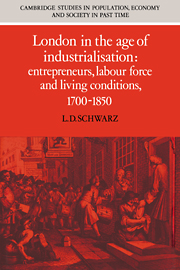Book contents
- Frontmatter
- Contents
- List of figures
- List of tables
- Acknowledgements
- List of abbreviations
- Introduction
- Part I Wealth and occupations in London
- Part II Fluctuations and mortality in the metropolis
- Part III The standard of living and the London trades
- Conclusion: downstream from industrialisation
- Appendices
- Bibliography
- Index
- Cambridge Studies in Population, Economy and Society in Past Time
Part I - Wealth and occupations in London
Published online by Cambridge University Press: 11 September 2009
- Frontmatter
- Contents
- List of figures
- List of tables
- Acknowledgements
- List of abbreviations
- Introduction
- Part I Wealth and occupations in London
- Part II Fluctuations and mortality in the metropolis
- Part III The standard of living and the London trades
- Conclusion: downstream from industrialisation
- Appendices
- Bibliography
- Index
- Cambridge Studies in Population, Economy and Society in Past Time
Summary
Seventeenth-century London was a town with two centres. The ‘old’ London consisted of the City, the centre of trade and finance, flanked by the Port and by the manufacturing suburbs of the Tower, Clerkenwell and Southwark. The ‘new’ London was in Westminster, with its Court and Parliament, with its developing squares, its aristocratic Season, its large glass-plated shops, its luxury trades and craftsmen. During the course of the eighteenth century the two centres were joined together – a geographical reflection of a unity that existed economically if not always politically. But at the start of the nineteenth century this duality – the different economic, administrative and geographical roles of the Port and the Court – was still clearly recognisable. The inner City, or ‘City within the Walls’, with a population of around 70,000 – a seventh of the capital's population – at the beginning of the eighteenth century, which fell to 56,000 – a twentieth part – in 1821, was far wealthier than the outer City, the ‘City without the Walls’, which had some 50,000 inhabitants in 1700 and about 65,000 during the first half of the nineteenth century. Westminster, in the meanwhile, had a population of perhaps some 70,000 in 1700, which had risen to over 150,000 by 1801 and was up to 237,000 half a century later. During the eighteenth century Westminster was expanding as rapidly as any of the London suburbs. During the first half of the nineteenth century it grew by over 50 per cent, but the nineteenth–century population explosion took place largely in the new ‘outer’ London, the ring of parishes surrounding the City, Westminster and Southwark.
- Type
- Chapter
- Information
- London in the Age of IndustrialisationEntrepreneurs, Labour Force and Living Conditions, 1700–1850, pp. 7 - 10Publisher: Cambridge University PressPrint publication year: 1992
- 2
- Cited by



